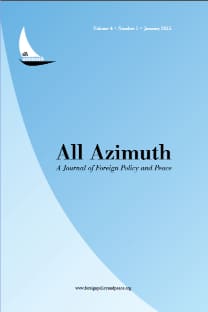A Guide to Event Data: Past, Present, and Future
A Guide to Event Data: Past, Present, and Future
Event data, NLP conflict, forecasting,
___
- Alt, James, Gary King, and Curt S. Signorino. “Aggregation among Binary, Count, and Duration Models: Estimating the same quantities from different levels of data.” Political Analysis 9 (2001):21-44.
- Azar, Edward E. “The Conflict and Peace Data Bank (COPDAB) Project.” Journal of Conflict Resolution 24 (1980):140-152.
- Azar, Edward E., Richard A. Brody, and Charles A. McClelland, eds. International Events Interaction Analysis: Some Research Considerations. Beverly Hills: Sage Publications, 1972.
- Baumeister, Roy F., and John Tierney. Willpower: Rediscovering the Greatest Human Strength. New York: Penguin, 2011.
- Bloomfield, Lincoln P., and Allen Moulton. CASCON III: Computer-Aided Systems for Analysis of Local Conflicts. Cambridge, MA: MIT Center for International Studies, 1989.
- Bond, Doug, Joe Bond, Churl Oh, J. Craig Jenkins, and Charles L. Taylor. “Integrated Data for Events Analysis (IDEA): An event typology for automated events data development.” Journal of Peace Research 40(6) (2003):733-745.
- Bond, Joe, Vladimir Petroff, Sean O’Brien, and Doug Bond. “Forecasting turmoil in Indonesia: An application of hidden Markov models.” Paper presented at the annual meeting of the International Studies Association, Montreal, Quebec, October 6-8, 2004.
- Buhaug, Halvard, and Jan Ketil Rod. “Local Determinants of African Civil Wars, 1970-2001.” Political Geography 25(6) (2006):315-335.
- Buhaug, Halvard, Scott Gates, and Paivi Lujala. “Geography, Rebel Capability, and the Duration of Civil Conflict.”Journal of Conflict Resolution 53(4) (2009): 544–569.
- Cederman, Lars-Erik, and Kristian Skrede Gleditsch. “Introduction to Special Issue on ‘Disaggregating Civil War.’” Journal of Conflict Resolution 24(4) (2009): 590-617.
- Chen, A. H. and T.F. Siems. “The Effects of Terrorism on Global Capital Markets.” European Journal of Political Economy 20 (2004): 349–66.
- Correlates of War Project (COW). “Militarized Interstate Disputes (v3.10).” Accessed November 2011. http://www. correlatesofwar.org/COW2%20Data/MIDs/MID310.html.
- D’Orazio, Vito, James E. Yonamine, and Philip A. Schrodt. “Predicting Intra-State Conflict Onset: An Event Data Approach Using Euclidean and Levenshtein Distance Measures.” Paper prepared for delivery at the Annual Meeting of the Midwest Political Science Association, Chicago, March 31-April 3, 2011.
- Duval, Robert D., and William R. Thompson. “Reconsidering the Aggregate Relationship between Size, Economic Development, and Some Types of Foreign Policy Behavior.” American Journal of Political Science 24(3) (1980): 511-525.
- Eldor, R., and R. Melnick. “Financial Markets and Terrorism.” European Journal of Political Economy 20 (2004): 367–86.
- Fordham, Benjamin O. “Strategic Avoidance and the Diversionary Use of Force.” The Journal of Politics 67 1 (Feb., 2005): 132-153.
- Freeman, John R. “Systematic Sampling, Temporal Aggregation, and the Study of Political Relationships.” Political Analysis 1 (1989): 61-98.
- Gerner, Deborah J., Philip A. Schrodt, and Omur Yilmaz. “Conflict and Mediation Event Observations (CAMEO) Codebook.” Accessed November 2011. http://eventdata.psu.edu/data.dir/cameo.html.
- Gerner, Deborah J., Philip A. Schrodt, Ronald A. Francisco, and Judith L. Weddle. “The Machine Coding of Events From Regional and International Sources.” International Studies Quarterly 38 (1994): 91-119.
- Ghosn, Faten, Glenn Palmer, and Stuart Bremer. “The MID3 Data Set, 1993–2001: Procedures, Coding Rules, and Description.” Conflict Management and Peace Science 21 (2004): 133-154.
- Goldstein, Joshua S. “A Conflict-Cooperation Scale for WEIS Events Data.” Journal of Conflict Resolution 36 (1992): 369-385.
- Goldstein, Joshua S. “Reciprocity in Superpower Relations: An Empirical Analysis.” International Studies Quarterly 35(2) (1991): 195–209.
- Goldstein, Joshua S., and John R. Freeman. Three-Way Street: Strategic Reciprocity in World Politics. Chicago: University of Chicago Press, 1990.
- Hammerli, August, Regula Gattiker, and Reto Weyermann. “Conflict and Cooperation in an Actors’ Network of Chechnya Based on Event Data.” Journal of Conflict Resolution 50 (2006): 159-175.
- Harff, Barbara, and Ted Robert Gurr. “Systematic Early Warning of Humanitarian Emergencies.” Journal of Peace Research 35(5)(2001): 359-371.
- Hermann, Charles, Maurice A. East, Margaret G. Hermann, Barbara G. Salamore, and Stephen A. Salamore. CREON: A Foreign Events Data Sets. Beverly Hills: Sage, 1973.
- Jenkins, J. Craig, and Doug Bond. “Conflict-Carrying Capacity, Political Crisis, and Reconstruction: A Framework for the Early Warning of Political System Vulnerability.” The Journal of Conflict Resolution 45(1) (Feb., 2001): 3-31.
- Leetaru, Kalev, and Philip A. Schrodt. “GDELT: Global Data on Events, Location and Tone, 1979-2012.” Paper presented at the International Studies Association conference, San Francisco, April 2013.
- Warning Model of Haitian Flight.” Civil Wars 9(2) (2007a): 174-199.
- Sherman, Frank L., and Laura Neack. “Imagining the Possibilities: The Prospects of Isolating the Genome of International Conflict from the SHERFACS Datasets.” In International Event Data Developments: DDIR Phase II, edited by Richard L. Merritt, Robert G. Muncaster, and Dina A. Zinnes. Ann Arbor: University of Michigan Press, 1993.
- Taylor, Charles L. World Handbook of Political and Social Indicators. New Haven, CT: Yale University Press, 1972.
- Tetlock, Philip E. Expert Political Judgment: How Good Is It? How Can We Know? Princeton, NJ: Princeton University Press, 2005.
- Van Brackle, David M., and Janet E. Wedgwood, “Event Coding for HSCB Modeling – Challenges and Approaches.” Lockheed Martin Advanced Technology Laboratories. Accessed July 5, 2013. http://www.atl.external.lmco. com/papers/1916.pdf.
- Weidmann, Mils B., and Michael Callen. “Violence and Election Fraud: Evidence from Afghanistan.”British Journal of Political Science 43(1) (2013): 53–75.
- Yonamine, James E. “Predicting Future Levels of Violence in Afghanistan Districts Using GDELT.” March 2013. Unpublished. http://jayyonamine.com/wp-content/uploads/2013/04/Predicting-Future-Levels-of-Violence-in- Afghanistan-Districts-using-GDELT.pdf.
- ISSN: 2146-7757
- Yayın Aralığı: 2
- Başlangıç: 2012
- Yayıncı: Dış Politika ve Barış Araştırmaları Merkezi, İhsan Doğramacı Barış Vakfı
A Guide to Event Data: Past, Present, and Future
A Guide to Event Data: Past, Present, and Future*
Philip A. SCHRODT, James E. YONAMİNE
Roundtable Discussion on Event Data
Ersel Aydınlı, Özgür Özdamar, Pınar İpek, Balkan Devlen, Belgin Şan Akça, Haluk Özdemir, Saize Arsavun, Joseph Bond, Reşat Bayer, William Lowe, Curtis Signorino, Sean O'Brien, James Yonamine, Cihangir Baycan, Ertan Efegil, Musa Tüzüner
Data Quality for Measuring Political Protest and Government Change
